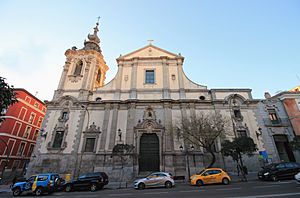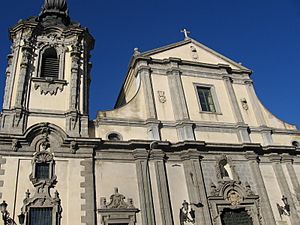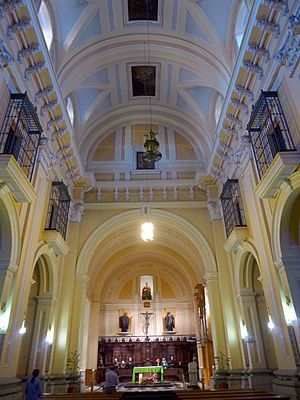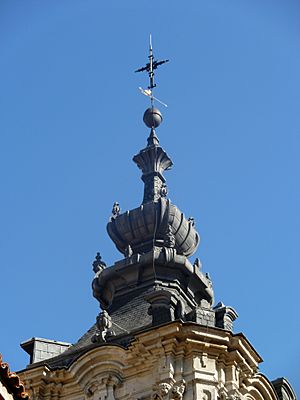Our Lady of Montserrat Church, Madrid facts for kids
Quick facts for kids Church of Nuestra Señora de Montserrat |
|
|---|---|
| Native name Spanish: Iglesia de Nuestra Señora de Montserrat |
|
 |
|
| Location | Madrid, Spain |
| Official name: Iglesia de Nuestra Señora de Montserrat | |
| Type | Non-movable |
| Criteria | Monument |
| Designated | 1914 |
| Reference no. | RI-51-0000136 |
| Lua error in Module:Location_map at line 420: attempt to index field 'wikibase' (a nil value). | |
The Church of Our Lady of Montserrat (Spanish: Nuestra Señora de Montserrat) is a beautiful Baroque-style church. You can find it in the center of Madrid, Spain. Even though its front on Calle San Bernardo looks very grand, the inside is smaller than planned. This is because the church was never fully finished.
Contents
History of the Church
How the Church Started
The church was started by King Philip IV. He wanted a home for monks from the Santa Maria de Montserrat Abbey in Catalonia. These monks were from Castile and had to leave their abbey during the Catalan Revolt. The Montserrat Abbey was a very important Benedictine center. Since 1493, it had been connected to the Castilian area of Valladolid. Catalan monks were not happy that their abbot was usually Castilian. So, during the revolt, they used the chance to make the Castilian monks leave.
Building the Church
Building the church began in 1668, during the rule of King Charles II. Sebastián Herrera Barnuevo was the first architect in charge. A rich man named Pedro Arnaldo Llansol de Romaní, who became the Marquis of Llansol, paid for the building.
The front of the church looks a bit like the famous Church of the Gesù in Rome. It is known as one of the most detailed and complex Baroque buildings in Madrid.
To deal with the street's slope, Herrera built the church on a tall base. He used pilasters, which are like flat columns, in a Doric style. After Herrera died in 1671, Gaspar de la Peña continued the work. However, he did not finish the main altar area or the front of the church.
Work stopped until 1716, when Pedro de Ribera took over. Ribera kept Herrera's original design for the front. But he added new decorations to the doors and windows. You can see the difference between Herrera's older windows and Ribera's newer ones. Ribera's designs have more fancy shapes and decorations.
The Church Towers
It is not clear if the original plans included two towers. However, their construction did not start until 1729. The first tower was finished in 1740. This tower shows Ribera's lively decorative style. It has a unique spire (a tall, pointed roof) that makes the church stand out. The top of the tower has two round windows on each side. These are framed by special decorative elements called estipites. The roof is made of slate and is topped with a globe and a cross.
Unfinished Grand Plans
Today, the church only has its main nave (the central part) and its side chapels. The parts that were built inside the monastery show that a much larger church was planned. However, there was not enough money to finish such a big project. The large dome, the main altar area, and the sacristies (rooms for priests) were never built. The church's current back wall was added in 1986. The style of the nave is from the late 17th-century Spanish Baroque. Ribera's work mainly added the beautiful decorations.
Changes Over Time
On July 25, 1835, a new law closed many religious houses with fewer than twelve religious members. Montserrat was one of over a thousand monasteries and convents in Spain that closed. In 1837, the monastery became a women's prison, known as Casa Galera.
In 1851, part of the monastery and church was given to nuns. They were later expelled in 1868. In 1918, the church was given to the Benedictine monks from the Abbey of Santo Domingo de Silos. On August 1, 1922, seven monks from Silos opened the north part of the church for worship. By 1928, the entire church was open again.
The Spanish Civil War (1936-1939) stopped the community's life. The monks had to find safe places to stay. The Popular Front turned the church into a ballroom. Three monks were imprisoned but later saved. Four other monks lost their lives during the conflict. In 1939, six monks from Silos returned to the monastery. In 1953, they also received the rest of the building that had been used as a women's prison. In 1988, the church and monastery were fully restored.
The writer Luis de Salazar y Castro was buried here. His valuable historical documents were kept in the monastery until 1835. When the monastery closed, these 49 volumes of documents were moved to the Royal Academy of History.
Long ago, it was a tradition to ring the bells every evening. This was done for the soul of King Philip IV, as it was the time the Benedictines learned of his death.
The church is sometimes called "el montserratico." Professor Bonet said it is a building you need to see in person, not just in pictures.
Artworks in the Church
The church has some important artworks. A large painting from the 18th century shows the Immaculate Conception in a unique way. There is also a sculpture of the Virgin Mary's head, thought to be by Manuel Pereira.
At the front of the church, there is a copy of the Christ of Burgos statue. This is a popular sculpture from the 18th century. Like the original, this statue has ostrich eggs at its feet. Tradition says these were a gift from a rich merchant from the Americas. In the novel "Miau" by Benito Pérez Galdós, the author describes how scary this statue looked with its real hair.
The paintings on the church's ceilings show stories from the life of Saint Benedict. These were made in the early 18th century by Pedro de Calabria. He also painted the shields under the choir and a large painting of St. Basil, which is now lost.
The church also had a beautiful painting by Antonio Fernández Arias. It showed the Pharisees asking Jesus about the tribute penny. This painting is now in the Prado. Another highly respected image in the church was that of Our Lady of Suffering.
Current Status
Today, the church is used by the Benedictine monks from Santo Domingo de Silos in the province of Burgos. It serves as their priory church.
See also
 In Spanish: Iglesia de Nuestra Señora de Montserrat para niños
In Spanish: Iglesia de Nuestra Señora de Montserrat para niños
- Catholic Church in Spain
- List of oldest church buildings





